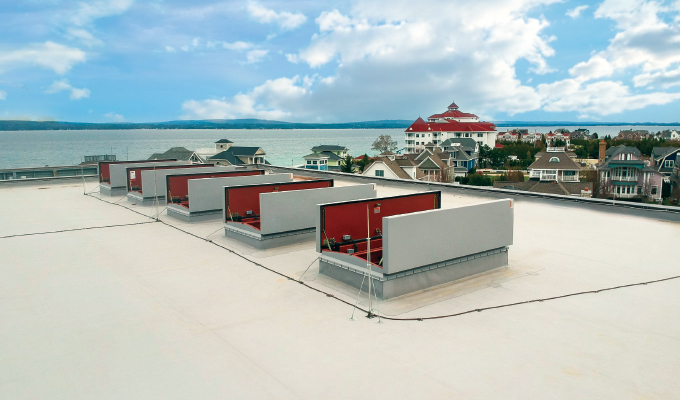By Thomas Renner
The team at Beecher Walker faced more than its share of challenges in the design and construction of The Hale Centre Theatre in Sandy, Utah. Weather, timing, and establishing a foundation strong enough to support the structure in watery soil were among the most pressing riddles facing the architects and construction management teams, and the room for error was as thin as a thimble.
THE CAREER PROJECT
One other concern confronting architects was solving acoustical issues. The theater, with a seating capacity for 1,360 patrons spread out over two theaters, sits below the flight path for planes heading into and out of a nearby airport. Cars, trucks, and other vehicles rumble past the theater on an adjacent highway. Nothing can destroy the mood of “Mary Poppins”—one of the Centre’s shows scheduled for this year—like the sound of the horn of a 16-wheeler rumbling past, the wail of sirens from an emergency vehicle, or thunder from an overhead airliner arriving for a landing.
With those underlying concerns in mind, every acoustical decision had to be on point. “This,” architect Lyle Beecher says, “is a career project.” His team selected every detail carefully, particularly as they related to acoustics. They constructed 18-inch thick concrete walls and installed mechanical equipment outside walls to minimize noise infiltration. They also selected 20 acoustical smoke vents manufactured by The BILCO Company. This year, BILCO introduced its new ACDSV smoke vent, which provides the highest level of protection against exterior noise intrusion. Smoke vents are also life safety products that also help protect the building structure.
“Air traffic was a big consideration for us,” Beecher says. “The smoke vents are the only thing stopping the noise coming in from the loading level on the outside. BILCO has a good reputation for its products and the sound issue was pretty intense.”
Acoustical performance is one of the major concerns for architects in the construction of theaters, stages, and other performance centers. The key indicators in equipment are ratings that fall into two categories: sound transmission class and outdoor-indoor transmission class. Depending upon the structure being built, the difference in ratings is essential for architects to understand.
TERMINOLOGY IN ACOUSTICS
While there are a lot of considerations in determining acoustic quality, building materials are largely measured by STC and OITC ratings. Architects and material specialists must not only select the materials with the proper rating for each project, but also must determine which measurement is more important for that particular project.
STC measures the extent to which sound is prevented from being transferred from one area to another. The higher the STC value, the less that sound can be transferred through a building product. STC is typically used to measure sound transmission loss over a frequency range from 125 to 4000 hertz and is most applicable for interior areas that experience mid to high-frequency noises, such as conversation, television, telephones, and office equipment. A product with a high STC value, ranging from 50-60, indicates that loud speech is barely heard (assuming a typical background sound level for an office, approximately 45dBA) through the product. A low STC rating, 20-25, indicates that loud speech would be audible through the product.
OITC rates the transmission loss of sound through a material when outdoor sources need to be considered. Like the STC rating, OITC measures sound intensity loss in decibels. The OITC rating was developed in 1990 and is typically used to measure sound transmission loss over a frequency range from 80 to 4000 hertz. It is most applicable for measuring the prevention of low-frequency exterior sounds such as automotive traffic, construction, and low-flying airplanes through exterior building surfaces.
“OITC is the preferred rating when addressing sound insulation from exterior noise—especially when transportation noise sources are impacting a building facade with significant low-frequency (bass) sound,” says Harold Merck, principal and acoustician for Merck & Hill Consultants of Atlanta. “While STC ratings may be fine for typical interior noise sources such as voices, STC doesn’t adequately address the extended low-frequency noise contribution of aircraft, traffic, or even large roof-top equipment. This also applies to large roof-top equipment noise sources as well. The OITC better addresses low-frequency noise impacts and is the more applicable sound rating for roof mounted automatic smoke vents.”
THE RIGHT CHOICE
According to Albert Maniscalco, a partner with Cerami and Associates in New York, the STC and OITC requirements vary according to each project.
In school construction, for instance, the STC ratings are used for acoustically rated doors and windows within the school such as for music practice rooms. However, the school may also require acoustically rated exterior windows or other façade elements to properly mitigate exterior noise intrusion. In this instance, the OITC rating would be used.
Maniscalco also explained that noise control works both ways. He cited the example where elements of a building exterior can be designed to keep the sound within the building such as a concert or sports venue that is near residences.
“Noise goes both ways,” Maniscalco says. “Sound can come in and go out. How that façade performs with noise coming in or going out is important to know.”
Building materials include STC and OITC ratings, but architects have to account for various sources of noise and make the appropriate choices. “Windows might have an excellent STC rating, but without a high OITC rating, low-frequency sounds can be intrusive,” Merck says. “Windows with a high STC rating typically have the same OITC rating as windows with a lesser STC rating, which can be a bit misleading. Ratings that include the OITC are more useful to assess how well a window will isolate environmental noise.”

CONTROLLING NOISE
The new smoke vents from BILCO come with an STC rating of 50 and an OITC rating of 46, providing the highest level of protection against exterior noise intrusion. In addition, the product has also received an ISO-140-18 sound rating when tested against rainfall sound. The rating measures the impact of sound insulation on building materials—such as roofs, skylights, and roof/ceiling systems—incur when exposed to artificial rainfall.
Automatic smoke vents are life safety products that are generally used in large one-story buildings per National Fire Protection Association (NFPA) standards. In the event of a fire, the vents exhaust smoke, heat, and burning gases from the building to improve visibility and to protect the building structure. This provides safe egress for building occupants and allows firefighters to enter the building and contain the fire.
The new design of the BILCO acoustical smoke vent features mineral wool insulation and high-density sound mat material within the unit’s covers and curb to better inhibit sound transmission. Structural improvements include the use of heavier gauge steel for the curb and cover liner, a new cover gasketing system, gas-spring lift assistance, and a center-mounted gas traction spring to ensure reliable and controlled smoke vent operation.
CLOSING THOUGHT
At the Hale Centre Theatre, the smoke vents provided a critical safety component while also protecting against noise infiltration. The new theater provides more than twice the seating capacity of its former facility, and gives patrons a first-class experience—without having to hear the nuisance of exterior noise.
“This theater, by all standards, is a world-class venue,” says Mark Dietlein, the president, CEO and executive director of the theater.
About the author:
Thomas Renner writes on building, construction, manufacturing, and other topics for U.S.-based trade publications.
Modern Contractor Solutions, August 2020
Did you enjoy this article?
Subscribe to the FREE Digital Edition of Modern Contractor Solutions magazine.



